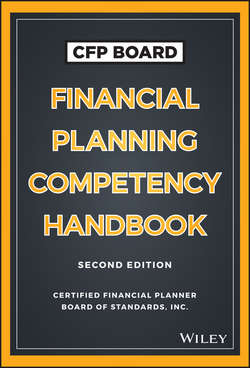Читать книгу CFP Board Financial Planning Competency Handbook - Board CFP - Страница 10
На сайте Литреса книга снята с продажи.
PART One
Introduction
CHAPTER 1
Theory and Practice
ОглавлениеCharles R. Chaffin, EdD
CFP Board
This book is designed for the discipline of financial planning – practitioners, faculty, and students. Regardless of discipline, practitioners gain from reconnecting with theory as well as questioning how it may relate to practice and their specific work. Faculty gain from witnessing how their work, whether research or teaching, relates to practice as a whole. Students wishing to join a given profession gain not only from acquiring a basic understanding of the theory associated with a given field, but also from learning, observing, and ultimately demonstrating the necessary skills and abilities associated with current practice.
At the risk of oversimplifying, this book is essentially divided into three parts: What a financial planner should know, what a financial planner does, and a systematic expansion of the body of knowledge for this discipline, incorporating related topics and disciplines. Chapters 2 to 70 outline the topics that encompass the content found within many financial planning preparation programs. The objective within Part One is to outline the topic and then discuss competencies relative to a given area. Competencies may be defined relative to a financial planning classroom or online learning platform or may be relative to the career track of the individual with years of financial planning practice. Just as important, this part outlines the contexts in financial planning practice in which these competencies are needed. It is not enough to merely know a particular area; the practitioner must also know when to utilize such competencies in a given context or scenario.
The second part of this book, Chapters 71 to 77, explores what a financial planner actually does in practice. Based on the steps of the financial planning process, this section outlines the action performed by the financial planner as well as the rationale for such action. These chapters then outline some of the techniques utilized in practice. Finally, as with each concept, vignettes outline the contexts in which such actions would be necessary and appropriate given client situations or professional rules of conduct. The vignettes in each chapter follow one specific case through each step of the process, highlighting the need for this process relative to one specific context.
Part Three provides an opportunity to expand financial planning research and practice into related disciplines, exploring the theory and implications of psychology, marriage and family therapy, behavioral finance, and others. In each of these chapters, the hope is for the diverse audiences of this book to gain insight into their particular areas: for the researcher to think about new lines of inquiry that will expand the body of knowledge; the practitioner to think about the implications of these disciplines and develop new tools that bring them into practice; and the students to make the connection between this new theory and its connection to practice as they aspire to become the next generation of financial planning practitioners, faculty members, researchers, or a combination of all three.
Finally, Chapter 88 offers a vision for the profession of financial planning, examining the changing demographics of the client and financial planner, future areas of research within the discipline, and the evolution of the role of the financial planner.
